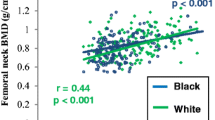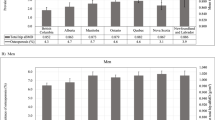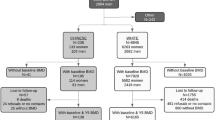Abstract
Introduction
Canadian Aboriginal women are at increased risk of fracture compared with the general population.
Hypothesis
There is disproportionately reduced bone density in Aboriginal women as compared to white females of similar age.
Methods
A random age-stratified (25–39, 40–59 and 60–75) sample of Aboriginal women (n=258) and white women (n=181) was recruited. All subjects had calcaneus and distal forearm bone density measurements, and urban participants (n=397 [90.4%]) also had measurements of the lumbar spine, hip and total body.
Results
Unadjusted measurements were similar in the two groups apart from the distal forearm which showed a significantly lower mean Z-score in the Aboriginal women (p=0.03). Aboriginal women were heavier than white women (81.0±18.0 kg vs. 76.0±18.0 kg, p=0.02). Weight was directly associated with BMD at all measurement sites (p<0.00001) and potentially confounded the assessment of ethnicity on bone mass measurements. Weight-adjusted ANCOVA models demonstrated significantly lower bone density in Aboriginal than white women for the calcaneus, distal forearm, and total body (all p<0.05), but not at the other sites. ANCOVA models (adjusted for age, height and weight) were used to explore differences in bone area and bone mineral content (BMC). There was a significant effect of ethnicity on bone area with Aboriginal women having larger adjusted mean values than white women (lumbar spine p=0.038, total hip p=0.0004, total body p=0.020). In contrast, there was no detectable effect of ethnicity on BMC (all p>0.2).
Conclusions
We identified significant site-specific differences in age-and weight-adjusted bone density for Aboriginal and white women. Larger bone area, rather than a reduction in BMC, appeared to be primarily responsible. Further work is needed to define how these differences in bone density and geometry affect indices of bone strength.

Similar content being viewed by others
Notes
In Canada, the terms Aboriginal or native are used to refer to “Indians”, and includes First Nations, Metis and Inuit peoples. First Nations are Aboriginal peoples signatory to treaties and/or recognized by the federal government as a fiduciary responsibility. This paper reports on data derived exclusively from First Nations populations which represent the large majority of Aboriginal persons living in Canada.
References
Kanis JA, Johnell O, De Laet C, Jonsson B, Oden A, Ogelsby AK (2002) International variations in hip fracture probabilities: implications for risk assessment. J Bone Miner Res 17:1237–1244
Looker AC, Wahner HW, Dunn WL, Calvo MS, Harris TB, Heyse SP, Johnston CC Jr, Lindsay R (1998) Updated data on proximal femur bone mineral levels of US adults. Osteoporos Int 8:468–489
Looker AC (2002) The skeleton, race, and ethnicity. J Clin Endocrinol Metab 87:3047–3050
Melton LJ III (2003) Epidemiology worldwide. Endocrinol Metab Clin North Am 32:1–13
Leslie WD, Derksen S, Metge C, Lix LM, Salamon EA, Wood SP, Roos LL (2004) Fracture risk among First Nations people: a retrospective matched cohort study. CMAJ 171:869–873
Leslie WD, Derksen SA, Metge C, Lix LM, Salamon EA, Steiman PW, Roos LL (2005) Demographic risk factors for fracture in First Nations people. Can J Public Health 96(Suppl 1):S45–S50
Jebamani LS, Burchill CA, Martens PJ (2005) Using data linkage to identify First Nations Manitobans: technical, ethical, and political issues. Can J Public Health 96(Suppl 1):S28–S32
Martens P, Sanderson D, Bond R, Jebamani L, Burchill C, Roos N, Tanner-Spence M, Derksen S, Leader A, Beaulieu M, Elias B, Steinbach C, O’Neil J, MacWilliam L, Walld R, Dik N (2002) The health and health care use of registered First Nations people living in Manitoba: a population-based study. Winnipeg, Manitoba, Manitoba Centre for Health Policy
Looker AC, Wahner HW, Dunn WL, Calvo MS, Harris TB, Heyse SP, Johnston CC Jr, Lindsay RL (1995) Proximal femur bone mineral levels of US adults. Osteoporos Int 5:389–409
Barrett-Connor E, Siris ES, Wehren LE, Miller PD, Abbott TA, Berger ML, Santora AC, Sherwood LM (2005) Osteoporosis and fracture risk in women of different ethnic groups. J Bone Miner Res 20:185–194
Cauley JA, Lui LY, Ensrud KE, Zmuda JM, Stone KL, Hochberg MC, Cummings SR (2005) Bone mineral density and the risk of incident nonspinal fractures in black and white women. JAMA 293:2102–2108
Ross PD, Norimatsu H, Davis JW, Yano K, Wasnich RD, Fujiwara S, Hosoda Y, Melton LJ III (1991) A comparison of hip fracture incidence among native Japanese, Japanese Americans, and American Caucasians. Am J Epidemiol 133:801–809
Ross PD, He Y, Yates AJ, Coupland C, Ravn P, McClung M, Thompson D, Wasnich RD (1996) Body size accounts for most differences in bone density between Asian and Caucasian women. The EPIC (Early Postmenopausal Interventional Cohort) Study Group. Calcif Tissue Int 59:339–343
Bhudhikanok GS, Wang MC, Eckert K, Matkin C, Marcus R, Bachrach LK (1996) Differences in bone mineral in young Asian and Caucasian Americans may reflect differences in bone size. J Bone Miner Res 11:1545–1556
Cummings SR, Cauley JA, Palermo L, Ross PD, Wasnich RD, Black D, Faulkner KG (1994) Racial differences in hip axis lengths might explain racial differences in rates of hip fracture. Study of Osteoporotic Fractures Research Group. Osteoporos Int 4:226–229
MacMillan HL, MacMillan AB, Offord DR, Dingle JL (1996) Aboriginal health. CMAJ. 155:1569–1578
Karmali S, Laupland K, Harrop AR, Findlay C, Kirkpatrick AW, Winston B, Kortbeek J, Crowshoe L, Hameed M (2005) Epidemiology of severe trauma among status Aboriginal Canadians: a population-based study. CMAJ. 172:1007–1011
Andersen S, Boeskov E, Laurberg P (2005) Ethnic differences in bone mineral density between inuit and Caucasians in north greenland are caused by differences in body size. J Clin Densitom 8:409–414
Deleze M, Cons-Molina F, Villa AR, Morales-Torres J, Gonzalez-Gonzalez JG, Calva JJ, Murillo A, Briceno A, Orozco J, Morales-Franco G, Pena-Rios H, Guerrero-Yeo G, Aguirre E, Elizondo J (2000) Geographic differences in bone mineral density of Mexican women. Osteoporos.Int. 11:562–569
Castro JP, Joseph LA, Shin JJ, Arora SK, Nicasio J, Shatzkes J, Raklyar I, Erlikh I, Pantone V, Bahtiyar G, Chandler L, Pabon L, Choudhry S, Ghadiri N, Gosukonda P, Muniyappa R, von-Gicyzki H, McFarlane SI (2005) Differential effect of obesity on bone mineral density in White, Hispanic and African American women: a cross sectional study. Nutr Metab (Lond) 2:9
Whiting SJ (2002) Obesity is not protective for bones in childhood and adolescence. Nutr Rev 60:27–30
Leonard MB, Shults J, Wilson BA, Tershakovec AM, Zemel BS (2004) Obesity during childhood and adolescence augments bone mass and bone dimensions. Am J Clin Nutr 80:514–523
Wang MC, Bachrach LK, Van LM, Hudes M, Flegal KM, Crawford PB (2005) The relative contributions of lean tissue mass and fat mass to bone density in young women. Bone 37:474–481
Petit MA, Beck TJ, Shults J, Zemel BS, Foster BJ, Leonard MB (2005) Proximal femur bone geometry is appropriately adapted to lean mass in overweight children and adolescents. Bone 36:568–576
Beck TJ, Oreskovic TL, Stone KL, Ruff CB, Ensrud K, Nevitt MC, Genant HK, Cummings SR (2001) Structural adaptation to changing skeletal load in the progression toward hip fragility: the study of osteoporotic fractures. J Bone Miner Res 16:1108–1119
De Laet C, Kanis JA, Oden A, Johanson H, Johnell O, Delmas P, Eisman JA, Kroger H, Fujiwara S, Garnero P, McCloskey EV, Mellstrom D, Melton LJ III, Meunier PJ, Pols HA, Reeve J, Silman A, Tenenhouse A (2005) Body mass index as a predictor of fracture risk: a meta-analysis. Osteoporos Int 16:1330–1338
Bolotin HH (1998) A new perspective on the causal influence of soft tissue composition on DXA-measured in vivo bone mineral density. J Bone Miner Res 13:1739–1746
Bolotin HH, Sievanen H, Grashuis JL, Kuiper JW, Jarvinen TL (2001) Inaccuracies inherent in patient-specific dual-energy X-ray absorptiometry bone mineral density measurements: comprehensive phantom-based evaluation. J.Bone Miner.Res. 16:417–426
Bolotin HH, Sievanen H, Grashuis JL (2003) Patient-specific DXA bone mineral density inaccuracies: quantitative effects of nonuniform extraosseous fat distributions. J Bone Miner Res 18:1020–1027
Lebrun JB, Moffatt ME, Mundy RJ, Sangster RK, Postl BD, Dooley JP, Dilling LA, Godel JC, Haworth JC (1993) Vitamin D deficiency in a Manitoba community. Can J Public Health 84:394–396
Campbell M, Diamant RMF, MacPherson BD, Grunau M, Halladay J (1994) Energy and nutrient intakes of men (56–74 years) and women (16–74 years) in three northern Manitoba Cree communities. J Can Diet Assoc 55:167–174
Ellestad-Sayed JJ, Haworth JC, Coodin FJ, Dilling LA (1981) Growth and nutrition of preschool Indian children in Manitoba: II. Nutrient intakes. Can J Public Health 72:127–133
Clark EM, Ness A, Tobias JH (2005) Social position affects bone mass in childhood through opposing actions on height and weight. J Bone Miner Res 20:2082–2089
Wang MC, Dixon LB (2006) Socioeconomic influences on bone health in postmenopausal women: findings from NHANES III, 1988–1994. Osteoporos Int 17:91–98
Spindler A, Lucero E, Berman A, Paz S, Vega E, Mautalen C (1995) Bone mineral density in a native population of Argentina with low calcium intake. J Rheumatol 22:2148–2151
Perry HM III, Bernard M, Horowitz M, Miller DK, Fleming S, Baker MZ, Flaherty J, Purushothaman R, Hajjar R, Kaiser FE, Patrick P, Morley JE (1998) The effect of aging on bone mineral metabolism and bone mass in Native American women. J Am Geriatr Soc 46:1418–1422
Filner JJ, Krohn KD, Lapidus JA, Becker TM (2002) Risk factors for osteoporosis in Alaska Native women: a cross-sectional survey. Alaska Med 44:8–13, 21
Evers SE, Orchard JW, Haddad RG (1985) Bone density in postmenopausal North American Indian and Caucasian females. Hum Biol 57:719–726
Krieger N, Davey SG (2004) “Bodies count,” and body counts: social epidemiology and embodying inequality. Epidemiol Rev 26:92–103
Cooper R (2002) In: LaVeist TA (ed) A note on the biological concept of race and its application in epidemiologic research. Jossey-Bass, San Francisco. pp 99–114
Muntaner C, Nieto FJ, O’Campo P (2002) In: LaVeist TA (ed) The bell curve: on race, social class, and epidemiologic research. Jossey-Bass, San Francisco pp 129–140
Acknowledgements
The authors would like to thank the rest of the First Nations Bone Health Study Research Group: Dr. C.R. Greenberg, Dr. L. Lix, Dr. A. Tenenhouse, Dr. J. Krahn, Dr. L. Roos, Dr. E.A. Salamon, and Ms. A. Walker Young. The authors are indebted to Health Information Management of Manitoba Health and to the First Nations and Inuit Health Branch and Indian and Northern Affairs Canada for permission to use the Status Verification System, and to the Health Information Research Committee of the Assembly for Manitoba Chiefs for actively supporting this work.
Author information
Authors and Affiliations
Corresponding author
Additional information
Supported by a grant from the Canadian Institutes for Health Research and the Manitoba Health Research Council.
Rights and permissions
About this article
Cite this article
Leslie, W.D., Metge, C.J., Weiler, H.A. et al. Bone density and bone area in Canadian Aboriginal women: the First Nations Bone Health Study. Osteoporos Int 17, 1755–1762 (2006). https://doi.org/10.1007/s00198-006-0184-0
Received:
Accepted:
Published:
Issue Date:
DOI: https://doi.org/10.1007/s00198-006-0184-0




